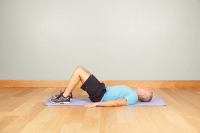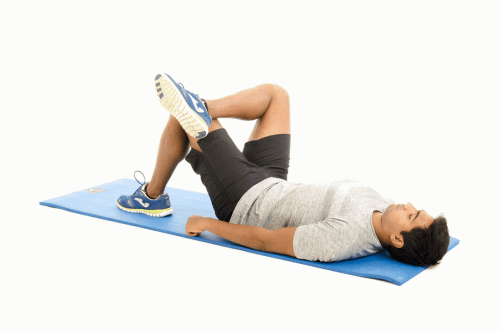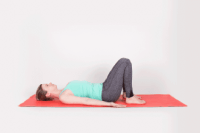Lower back and thigh pain is a rather common complaint among females, and it can significantly impact their daily lives and mobility. Understanding the potential causes, recognizing the symptoms, and exploring relief options are crucial steps toward managing and alleviating this discomfort. In this blog, we are going to delve into the various factors that can contribute to lower back and thigh pain in females and discuss effective ways to find relief.
Contents
- 1 Common Causes Of Lower Back And Thigh Pain In Women
- 2 Exercises To Relieve Lower Back And Thigh Pain In Females
- 3 Non-Surgical Treatment Options For Women’s Lower Back And Thigh Pain
- 4 Surgical Interventions For Severe Lower Back and Thigh Pain
- 5 Coping Strategies For Women Living With Chronic Lower Back And Thigh Pain
- 6 Conclusion
Common Causes Of Lower Back And Thigh Pain In Women
Lower back and thigh pain in women can be attributed to various factors, ranging from musculoskeletal issues to gynecological conditions. Here are some prevalent reasons behind lower back and thigh pain in women:
- Muscle Strain: Overexertion, lifting heavy objects, or sudden movements can lead to muscle strain in the lower back and thighs, resulting in pain.
- Sciatica: Sciatica occurs when the sciatic nerve, which runs from the lower back down through the thighs, becomes compressed or irritated. This often causes radiating pain in the lower back and one leg.
- Piriformis Syndrome: The piriformis muscle in the buttocks can sometimes compress the sciatic nerve, causing pain that radiates down the back of the thigh.
- Ovarian Cysts: Ovarian cysts, especially if they grow large or rupture, can induce lower back and thigh pain.
- Endometriosis: This condition involves the growth of endometrial tissue outside the uterus, potentially leading to pain in various areas, including the lower back and thighs, especially during menstruation.
- Pelvic Inflammatory Disease (PID): Infections in the reproductive organs, such as PID, can cause referred pain to the lower back and thighs.
- Pregnancy: During pregnancy, the body undergoes significant changes that can result in lower back and thigh pain due to increased pressure on the spine and pelvic region.
- Fibromyalgia: This chronic pain condition can manifest as widespread pain, including the lower back and thighs, in some women.
- Menstrual Cramps: Severe menstrual cramps, known as dysmenorrhea, can radiate pain to the lower back and thighs.
- Musculoskeletal Conditions: Conditions like herniated discs, spinal stenosis, or osteoarthritis can lead to lower back pain that may extend into the thighs.
- Stress and Tension: Emotional stress and tension can manifest physically, leading to muscle tension and pain in the lower back and thighs.
Exercises To Relieve Lower Back And Thigh Pain In Females
Incorporating targeted exercises into your routine can help alleviate discomfort and improve your overall mobility. Here are some exercises that may help relieve lower back and thigh pain in females:
Pelvic Tilts
- Lie on your back with your knees bent and feet flat on the floor.
- Tighten your abdominal muscles and gently tilt your pelvis upward, pressing your lower back into the floor.
- Hold for a few seconds and then release.
- Repeat 10-15 times.
Cat-Cow Stretch
- Start on your hands and knees in a tabletop position.
- Inhale, arch your back (Cow Pose), and look up.
- Exhale, round your back (Cat Pose), and tuck your chin to your chest.
- Repeat this fluid motion for 1-2 minutes.
Child’s Pose
- Kneel on the floor with your big toes touching and knees apart.
- Sit back on your heels and stretch your arms forward, lowering your chest toward the floor.
- Hold for 20-30 seconds while focusing on deep, relaxed breathing.
Piriformis Stretch
- Lie on your back with your knees bent and feet flat on the floor.
- Cross your right ankle over your left knee.
- Reach your hands behind your left thigh and gently pull it towards your chest.
- Hold for 20-30 seconds and switch sides.
Hamstring Stretch
- Sit on the floor with one leg extend
 ed straight and the other bent, foot against the inner thigh of the extended leg.
ed straight and the other bent, foot against the inner thigh of the extended leg. - Reach toward your toes on the extended leg, keeping your back straight.
- Hold for 20-30 seconds and switch legs.
Sciatic Nerve Glide
- Sit on a chair with your feet flat on the floor.
- Straighten your right leg and flex your foot.
- Gently lean forward, keeping your back straight, until you feel a stretch in the back of your thigh.
- Hold for a few seconds and then return to the starting position.
- Repeat 10-15 times on each leg.
Bridge Exercise
- Lie on your back with your knees bent and feet flat on the floor, hip-width apart.
- Lift your hips off the ground while squeezing your glutes.
- Hold for a few seconds and lower your hips back down.
- Repeat 10-15 times.
Yoga and Tai Chi:
These mind-body practices can improve flexibility, balance, and posture while promoting relaxation and reducing pain.
Non-Surgical Treatment Options For Women’s Lower Back And Thigh Pain
Here are some non-surgical treatment options for women dealing with lower back and thigh pain:
- Physical Therapy: A physical therapist can design a customized exercise program to strengthen the muscles in the lower back and thighs, improve flexibility, and promote better posture. Physical therapy can be particularly effective for musculoskeletal issues and conditions like sciatica.
- Lifestyle Modifications: Practicing good posture, maintaining a healthy weight, and avoiding activities that exacerbate pain can significantly impact pain management.
- Ergonomic Adjustments: Making ergonomic changes to your workspace can reduce strain on your lower back and thighs. Use supportive chairs and maintain proper desk height, if applicable.
- Alternative Therapies: Techniques such as acupuncture, chiropractic care, and massage therapy may provide relief for some individuals. These therapies focus on addressing muscle tension and promoting relaxation.
- Stress Management: Since stress can worsen pain, practices such as deep breathing, meditation, and yoga can help manage emotional stress, potentially reducing muscle tension and pain.
- Pelvic Floor Physical Therapy: For conditions like endometriosis or pelvic floor dysfunction, specialized physical therapy can target the pelvic region to alleviate pain.
- Ultrasound-Guided Injections: In cases of more severe pain or inflammation, healthcare providers may recommend ultrasound-guided injections, such as epidural or nerve block injections, to target the source of the pain.
- Diet and Nutrition: Maintaining a balanced diet and staying hydrated can support overall health, potentially reducing inflammation.
Surgical Interventions For Severe Lower Back and Thigh Pain
When non-surgical treatment options prove ineffective in managing severe lower back and thigh pain in females, surgical interventions may be considered. Here are some common surgical interventions for severe lower back and thigh pain:
- Foraminotomy: In cases where the foramen, the opening through which spinal nerves exit the spine, is narrowed and causing nerve compression, a foraminotomy may be performed. This procedure widens the foramen to alleviate pressure on the nerves.
- Endometriosis Surgery: For women with severe lower back and thigh pain due to endometriosis, laparoscopic surgery may be necessary to remove endometrial tissue growths outside the uterus and address related issues.
- Ovarian Cyst Removal: Large or problematic ovarian cysts that are causing pain may require surgical removal. This can often be done laparoscopically to minimize recovery time.
- Spinal Fusion for Scoliosis: If scoliosis is the cause of lower back and thigh pain, spinal fusion surgery may be recommended to correct the spinal curvature and alleviate pain.
- Neurostimulation: In cases of chronic pain that do not respond well to other treatments, spinal cord stimulation or peripheral nerve stimulation devices may be implanted to interfere with pain signals.
- Myomectomy: For women with uterine fibroids causing lower back and thigh pain, a myomectomy can remove the fibroids while preserving the uterus.
Coping Strategies For Women Living With Chronic Lower Back And Thigh Pain
Chronic lower back and thigh pain can be physically and emotionally challenging, but there are coping strategies that can help improve your quality of life and manage the discomfort effectively. If you’re dealing with persistent pain, consider implementing these strategies:
- Medication Management: Work with your healthcare provider to find the right medication regimen for pain relief. Over-the-counter or prescription medications may be necessary to manage chronic pain effectively.
- Supportive Devices: Consider using lumbar support cushions, orthotic inserts, or mobility aids to reduce strain on your lower back and thighs and improve your overall comfort.
- Heat and Cold Therapy: Utilize heat packs or cold packs as needed to alleviate pain and reduce inflammation. Experiment to find which therapy works best for you.
- Maintain a Healthy Lifestyle: Follow a balanced diet, stay hydrated, and maintain a healthy weight to reduce the strain on your lower back and thighs. Avoid excessive alcohol and tobacco use, as these can worsen pain.
- Stay Active: Engage in low-impact activities like swimming, walking, or gentle yoga to keep your body moving. Staying active can help prevent muscle atrophy and stiffness.
- Support Network: Lean on friends and family for emotional support. Chronic pain can be isolating, so having a support network can help you cope with the challenges it brings.
- Mental Health Support: Consider seeking counseling or therapy to address the emotional impact of chronic pain. Conditions like depression and anxiety often accompany chronic pain and can benefit from professional treatment.
- Pace Yourself: Learn to recognize your limitations and pace yourself accordingly. Avoid overexertion, and prioritize self-care to prevent flare-ups.
- Adaptive Strategies: Modify your daily activities and environment to accommodate your pain. This may include ergonomic adjustments at work or home to reduce strain.
Conclusion
In conclusion, dealing with lower back and thigh pain in females can be challenging, but it’s important to seek professional guidance and personalized treatment. By taking a comprehensive approach that may involve physical therapy, medication, and lifestyle adjustments, you can better manage your pain and improve your quality of life. Remember, you’re not alone, and there are ways to find relief and support on your journey to better health.
If you’re experiencing Back pain, physical therapy for back pain at PhysioMantra can help: Book an online physical therapy session.







 ed straight and the other bent, foot against the inner thigh of the extended leg.
ed straight and the other bent, foot against the inner thigh of the extended leg.




